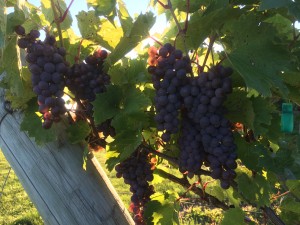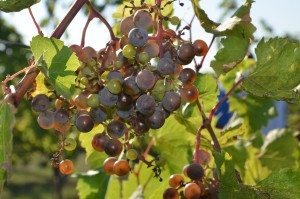Setting Up a Bigger Harvest
Nutrient management is key to improving fruit set, volume of wine
Upper Midwest soils have always been perfect for bumper crops of corn and soybeans and are increasingly becoming a source of award-winning grapes for wine. Just as row-crop farmers apply manure, potash or other supplements to their soil to boost nutrient levels, vineyard owners are also looking at ways to balance their soils to achieve an optimum fruit set.
Larry Shafer of Agro-K, a Minneapolis-based company specializing in customized soil and plant nutrition products, said grape vines tend to grow well in the Midwest, as the soil is rich in nitrogen. ‘However, that is only one of the ‘big three’ base nutrients (nitrogen, phosphorus and potassium, commonly known by their chemical symbols N, P and K) that is regularly encountered in most vineyards.”
These two photos above show the ‘before” and ‘after” effect that Round Lake Vineyards has experienced now that they employ a foliar feeding program. Good fruit sets are now the norm at this southwest Minnesota vineyard.
‘In 85 to 90 percent of the tissue tests I take, I will find the nitrogen to be really high, with the phosphorus being OK and the potassium being really low.”
Foliar feeding
Research has pointed out the multiple benefits in taking a ‘foliar feeding” approach of spraying base and micronutrients to keep the vine in balance. Dr. Dirk Uys, a former professor and senior lecturer at the University of Stellenbosch in South Africa, found several advantages such as a significant increase in bunch weight, with an overall significant increase in crop yield. ‘Another important aspect was that berry weight did not change significantly and that fears of larger berries producing a lower berry skin to juice ratio are unfounded,” he wrote.
Dr. Dennis Culver, a certified entomologist and crop advisor from Visalia, California, considers foliar feeding to be the ‘Holy Grail” of vine nourishment, and has turned numerous vineyards on to the program with success. Specifically speaking of potassium formulations, Culver said it ‘increases anthocyanins and really punches up all the characteristics you want in wine” (Ness).
During periods of unusual weather such as the Midwest experienced in 2014, the need for nutrients becomes greater than normal due in a large part to the excessive moisture that much of the region saw in the spring. ‘Vines are growing so fast that they are getting ahead of the nutrients,” Shafer said. ‘We need to build the carbohydrates into the vines, so when they go dormant in the fall they will be well-fed and ready for winter.”
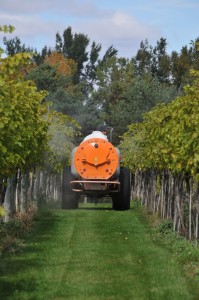
Multiple researchers have pointed out benefits to foliar feeding. Figuring out the ideal spray timing and program for each individual vineyard is as important as identifying what nutrients are needed.
Unfortunately, as some growers found out, skipping that fall feed can result in poor outcomes in the spring. The 2013 harvest was delayed by up to two weeks in many areas, leading affected growers to skip the fall feeding. In addition, the sudden drop of temperatures in December shocked the vines. They had not benefitted from a gradual cool-down as occurs in most years. This spring many growers saw their cold-hardy vines stunted, stressed and dehydrated, since they lacked the nutrients necessary for proper hibernation.
Finding the right program
For many growers, finding the correct balance of products and application strategies is not an easy task. Every company claims to have ‘the next big thing,” so growers often find themselves experimenting with various mixes and protocols, often with mixed results.
Round Lake Vineyards of Round Lake, Minnesota, has struggled to find a program that worked for their vines. Located in the southwest corner of the state, Round Lake Vineyards grows 13 different varieties of grapes on 18 acres. The majority of their produce had previously been sold to area wineries, but plans for an on-site winery are in the works. Owner Scott Ellenbecker had tried a variety of chemicals, fertilizers and supplements in the past, with varying results.
‘We had issues with the fruit not fully extending out,” Ellenbecker explained. ‘The grape bunches were not fully developing, leaving dead spaces in the middle or end of the bunch. We also had underdeveloped berries in a bunch. It just seemed to me that the nutrients were not feeding the plant correctly.”
The spray contained a growth promotant that occurs naturally in seaweed in very high levels. When present in low levels, this stimulates a plant’s enzymes. Concentrated, it acts as a stress reliever and, in high enough levels, activates the plant, giving it energy needed to stretch out fruit production. This was exactly the result that Ellenbecker was looking for.
‘I wanted to maximize the fruit set on each bunch. Underdeveloped fruit is money lost when most of the work has already been done by the plant,” said Ellenbecker.
The right spray at the right time
Ideally the spray should be applied when the flower shoots are 1 to 2 inches long, to best affect the structure of the bunch. A second application at 10 days pre-bloom will help the stressed plant push the flowers to pollination.
‘The whole process, from flowering through pollination, benefits,” Ellenbecker said.
Growers like Ellenbecker are seeing an increased volume of wine from their vines post-application. Traditional mindset is that plant stress and small berries are necessary for better wine. However, more and more growers are finding that that is not the case. As long as a vine is healthy and properly ‘fed,” the result will be good wine with consistent results.
One grower who is experiencing this firsthand is William Bahl of New Albany, PA. Bahl has a hobby
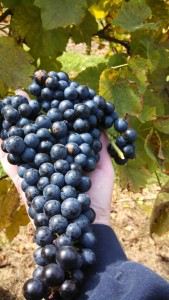
While the common belief has always been that bigger clusters and bigger berries mean lower juice quality, Pennsylvania grower William Bahl has found the opposite to be true. Since adopting a foliar feeding program in his New Albany vineyard, he has been producing larger clusters that yield the kind of juice wineries desire.
vineyard on 2.5 acres, and he sells the grapes to a local winery. He has been using Agro-K foliar feeding products for two years now, mainly to help curb diseases such as black rot and powdery and downy mildew.
‘When I first started, I had issues with vines being planted too close together, so I had to bite the bullet and tear out about 400 vines,” Bahl said. ‘But after doing that and setting up a program with Agro-K I’ve made up the losses in production. Compared from last year to this year I spent half the time spraying and doubled or tripled my production.”
The increased production and healthier vines are noticed in both the vineyard and the winery.
‘People say the bigger clusters and bigger berries mean less quality in the juice, but that’s not the case. The winery that I sell to has some of the same varieties of grapes. This year we kept my grapes separate to compare juice quality, and he told me that, comparing the two, the quality of juice from my grapes is much higher than the juice from his,” he said.
‘The quality of the juice that he has in the tanks and barrels right now is just phenomenal, and the winery is tickled pink.”
Laddsburg Mountain Winery‘s vineyard, which is also on a nutrient program (not Agro-K), is only eight miles from Bahl’s. The similarity and proximity of their two operations has led owner Steve Grazaitis to set up an informal comparison study over the past few years.
‘With all three targets that we looked at — pesticide use, fruit quality and cluster size — his results were noticeably better when he started using the Agro-K,” he said.
Last summer was unusual in the Northeast. The temperature often dropped significantly at night, affecting the ability of the fruit to produce sugars. However, Grazaitis noted, juice from Bahl’s grapes averaged 1.5 to 2 degrees Brix better than his own did. When it came to cluster size, Bahl again had better results, averaging larger bunches in both the Catawba and Cayuga varieties.
The most noticeable difference, however, was in pesticide use.
‘If I did 10 sprays last year,” Grazaitis said, ‘he maybe did 7. Pesticide reduction is a big target for us, both for environmental reasons as well as cost.”
This year Grazaitis has plans to use Agro-K foliar feeding programs in his own vineyard. ‘I’ve always been a believer in nutrient products,” he said. ‘Up where we are at, in the Northeast, you don’t have a choice. And after several years of seeing these results, I can definitely say that the Agro-K products made a clear difference.”
Ellenbecker first applied the spray in the summer of 2011 on an experimental basis.
He said, ‘I will always try something new. I started with a lighter and inconsistent application routine, but today I follow the recommended schedule closely. I can see how the plants have improved through better bunch development and increased harvest weights. Today when we apply fertilizers, it’s a cocktail of base and trace nutrients. We do tissue sampling a few times a season to monitor and correct the plant’s diet, if necessary.”
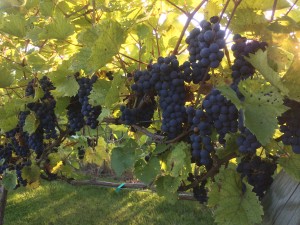
Healthy fruit sets such as this Marquette vine are now the norm rather than the exception at Round Lake Vineyards. The southwest Minnesota vineyard has begun to employ a foliar feeding program that assists in stress relief and gives the plant needed energy to stretch out fruit production.
Trace nutrient application is not limited to grapes. Field trials from Texas have shown benefits to fruit quality when nutrients are applied to cantaloupe and honeydew melons on the vine. As the researchers explained, ‘due to many environmental factors, plants cannot absorb enough of these minerals from the soil during fruit formation to ensure optimum fruit quality standards.” Timely foliar feeding, then, acts as a supplement to replenish those missing minerals. Melons treated with foliar sprays of calcium demonstrated a shelf life nearly double the norm, while adding potassium contributed to increased fruit sugar, beta-carotene and vitamin C levels. This fruit also matured 2 to 3 days earlier than normal (Lester, Jifon).
Versatile applications
Some growers are trying a different schedule this year, applying two pre-bloom sprays with one 4-5 days earlier than normal and the second 8 days later. ‘Maybe by widening that window,” Shafer said, ‘we can catch something new that we hadn’t gotten with the traditional application schedule.”
Foliar feeds can be applied with a wide mix of other products. Most fungicides and insecticides can be applied with the spray as long as label directions are followed. However, Shafer cautioned that what works for one variety may have to be adjusted for another. ‘Varieties are all different,” he said. ‘They are all in different stages and you have to treat them differently. The right nutrient at the right time will get you quality fruit.”
In 2014, Round Lake Vineyards sprayed their varieties in early June, then again about two weeks later. Both applications had the nutrients mixed with several other nutrient sprays, as well as a fungicide.
Bahl agreed that having the right spray schedule and timing is key.
‘The first year that I sprayed, I saw some good results, but this year we adjusted the program and have had some great results. Of course, a lot depends on if Mother Nature plays into your hand, with battling frost, rains, birds and all of that — it’s hard to have an ideal year, but this year I’m really seeing what these grapes can produce. The quality of the juice is just phenomenal.
‘It’s all about the timing of the sprays and timing when the berries are coming into bloom,” he said. ‘Keeping the vines healthy and producing the nice clusters of berries gives you higher quality wine and better flavor.”
Ongoing process
‘Quality fruit is the result of a deliberate, long-term process,” Shafer said. ‘Good, intentional management of the vine will reduce the stress on the plant and allow it to do what it should do. It might take a year or two to get the fruit set that you want, but it’s a process. It’s not automatic.
This article was contributed by the Agro-K Corporation in Minneapolis. Agro-K has been a pioneer in foliar nutrition and soil conditioning systems for over 35 years.
REFERENCES:
Lester, Gene, and John Jifon. 2005. K and calcium boost melon quality. Fluid Journal, Fall 2005.
Ness, Laura. 2008. Vine nutrition and health: Reading leaves to bring vineyards into balance. Vineyard & Winery Management. November-December 2008.
Uys, D.C. 1997. The effect of supplemental foliar feeding potassium and other nutrients on production and quality of wine grapes.

